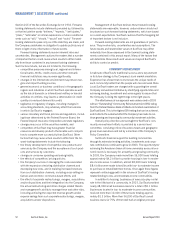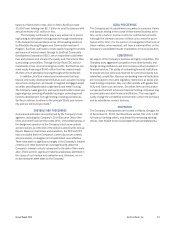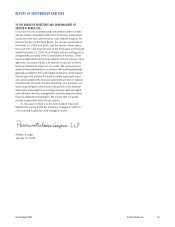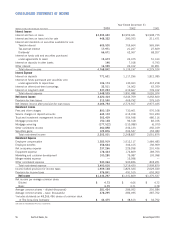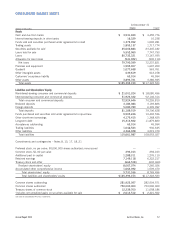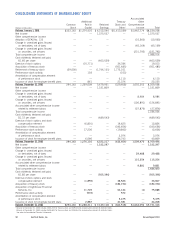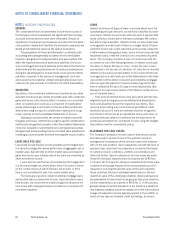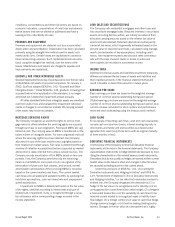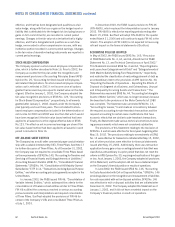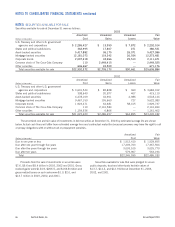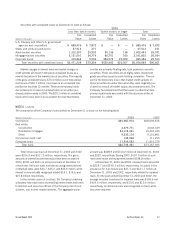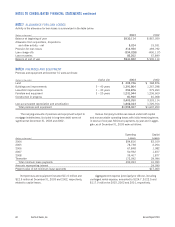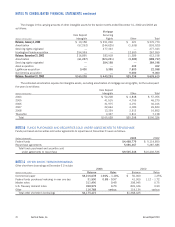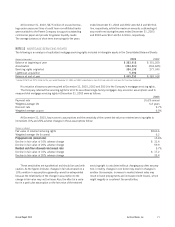SunTrust 2003 Annual Report Download - page 63
Download and view the complete annual report
Please find page 63 of the 2003 SunTrust annual report below. You can navigate through the pages in the report by either clicking on the pages listed below, or by using the keyword search tool below to find specific information within the annual report.
Annual Report 2003 SunTrust Banks, Inc. 61
conditions, concentrations and other risk factors are based on
economic indicators, concentrations of credit risk and adminis-
trative factors that are not otherwise addressed and have a
bearing on the collectibility of loans.
PREMISES AND EQUIPMENT
Premises and equipment are stated at cost less accumulated
depreciation and amortization. Depreciation has been calculated
primarily using the straight-line method over the assets’ esti-
mated useful lives. Certain leases are capitalized as assets for
financial reporting purposes. Such capitalized assets are amor-
tized, using the straight-line method, over the terms of the
leases. Maintenance and repairs are charged to expense and
improvements are capitalized.
GOODWILL AND OTHER INTANGIBLE ASSETS
Goodwill represents the excess of purchase price over the fair value
of identifiable net assets of acquired companies. On January 1,
2002, SunTrust adopted SFAS No. 142, “Goodwill and Other
Intangible Assets.” Under SFAS No. 142, goodwill, including that
acquired before initial application of the standard, is no longer
amortized but is tested for impairment at least annually.
All other identified finite-lived intangible assets are amortized
over their useful lives and evaluated for impairment whenever
events or changes in circumstances indicate the carrying amount
of the assets may not be recoverable.
MORTGAGE SERVICING RIGHTS
The Company recognizes as assets the rights to service mort-
gage loans for others whether the servicing rights are acquired
through purchase or loan origination. Purchased MSRs are capi-
talized at cost. The carrying value of MSRs is maintained on the
balance sheet in intangible assets. For loans originated and sold
where the servicing rights have been retained, the Company
allocates the cost of the loan and the servicing rights based on
their relative fair market values. Fair value is determined through
a review of valuation assumptions that are supported by market
and economic data collected from various outside sources. The
Company records amortization of the MSRs based on two com-
ponents. First, the Company amortizes fully the remaining
balance of all MSRs for loans paid-in-full in recognition of the
termination of future cash flow streams, and second, normal
amortization (amortization of the surviving MSRs) is recorded
based on the current market cash flows. The current market
cash flows are calculated and updated monthly by applying mar-
ket-driven assumptions, such as interest rate and prepayment
speed assumptions.
Impairment for MSRs is determined based on the fair value
of the rights, stratified according to interest rate and type of
related loan. Impairment, if any, is recognized through a valua-
tion allowance with a corresponding charge recorded in the
income statement.
LOAN SALES AND SECURITIZATIONS
The Company sells residential mortgages and other loans and
has securitized mortgage loans. Retained interests in securitized
assets, including debt securities, are initially recorded at their
allocated carrying amounts based on the relative fair value of
assets sold and retained. Retained interests are subsequently
carried at fair value, which is generally estimated based on the
present value of expected cash flows, calculated using manage-
ment’s best estimates of key assumptions, including credit
losses, loan repayment speeds and discount rates commensu-
rate with the risks involved. Gains or losses on sales and
servicing fees are recorded in noninterest income.
INCOME TAXES
Deferred income tax assets and liabilities result from temporary
differences between the tax bases of assets and liabilities and
their reported amounts in the financial statements that will
result in taxable or deductible amounts in future years.
EARNINGS PER SHARE
Basic earnings per share are based on the weighted-average
number of common shares outstanding during each period.
Diluted earnings per share are based on the weighted-average
number of common shares outstanding during each period, plus
common shares calculated for stock options and performance
restricted stock outstanding using the treasury stock method.
CASH FLOWS
For purposes of reporting cash flows, cash and cash equivalents
include cash and due from banks, interest-bearing deposits in
other banks and funds sold and securities purchased under
agreements to resell (only those items with an original maturity
of three months or less).
DERIVATIVE FINANCIAL INSTRUMENTS
It is the policy of the Company to record all derivative financial
instruments at fair value in the financial statements. The Company
uses derivative instruments to hedge interest rate exposure by mod-
ifying the characteristics of the related balance sheet instruments.
Derivatives that do not qualify as hedges are carried at their current
market value on the balance sheet and changes in their fair value
are recorded as trading income in the current period.
Under the provisions of SFAS No. 133, “Accounting for
Derivative Instruments and Hedging Activities” and SFAS No.
149, “Amendment of Statement 133 on Derivative Instruments
and Hedging Activities,” on the date that a derivative contract is
entered into, the Company designates the derivative as (1) a
hedge of the fair value of a recognized asset or liability or of an
unrecognized firm commitment (fair value hedge); (2) a hedge of
a forecasted transaction or of the variability of cash flows to be
received or paid related to a recognized asset or liability (cash
flow hedge); (3) a foreign currency fair value or cash flow hedge
(foreign currency hedge); or (4) held for trading (trading instru-
ments). Changes in the fair value of a derivative that is highly



